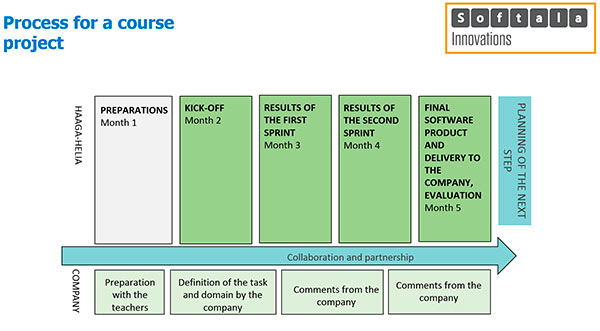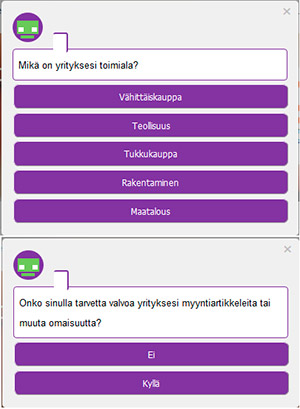
Introduction
ICT professionals are nowadays expected to understand customer needs and to communicate and work in multidisciplinary teams in order to reach overall business goals. As a result, the Finnish universities of applied sciences are answering to this demand by offering project based learning experiences where real-world problems are solved in teams consisting of students, teachers and representatives from companies. This prepares the students with the necessary competences on the highly competitive job market. This paper describes two case examples of how the development goals of a research and development (R&D) project and the needs of partner companies can be integrated into teaching. The ultimate goal is to develop pedagogical approaches where students solve real problems given by companies in an authentic environment.
This paper describes the development of new B2B sales tool prototypes in the software development and innovation project courses of Haaga-Helia University of Applied Sciences (UAS). The projects are a part of a TEKES-funded R&D project called DIVA. The tool prototypes are developed for the companies participating in the project. Close cooperation with the companies during the projects ensure that the results are useful and realistic, and that students learn software design and development competencies in an authentic environment.
Project-based learning in Information Technology Education
Haaga-Helia UAS has a relatively long tradition in conducting company-driven software development and innovation projects as a mandatory part of the curriculum of the Business Information Technology Programme. The process is depicted in Figure 1. As shown in the figure, the first step is a preparative meeting with the representatives of the company and with the staff concerned from Haaga-Helia UAS. In this preparative meeting issues such as immaterial rights to the end product, schedule of the project and a sketch concerning the technology and software architecture to be used, are agreed upon. The next step is the kick-off meeting with the students. In this meeting the company describes the task at hand and tells about the domain and business area in general. These presentations are usually followed by a vivid discussion. The project itself is executed using a SCRUM-like agile software development process. The materials collected in the kick-off meeting serve as a starting point for creating the initial version of the product backlog. There are three sprints. In the middle of the project, the intermediate results are presented to the company in the form of a functioning prototype. The company typically gives comments on this prototype. The comments have an effect on the contents and priorities of the product backlog. In the final meeting with the company, the finished version of the software is presented and delivered to the company. This last session also involves an evaluation on the successfulness of the project and some ideas for future development. In the next section we will describe two concrete projects which were implemented using this model.

Prototyping of a Sales Robot
The students of Haaga-Helia UAS developed a prototype of a sales robot in the fall term of 2015. The project was done in a software project course with approximately 30 students and two teachers. The project started in August with a kick-off presentation by the company. In this kick-off event the representatives of the company presented the product that was the target of sales in this first version of the sales robot. The presentation was followed by an interesting discussion concerning the features of the new product as well as issues in automating transaction selling in a b2b context. By transaction selling we mean here a rather straightforward selling process that is typically applied when selling large volumes of a relatively unexpensive product.
After the kick-off event, the students organized themselves into three groups with separate areas of responsibility. As a Scrum-like process was the chosen model of software development, each team chose a Scrum Master among its members. Other roles in the teams were such as: database expert, security expert, integration expert, user interface expert, content/ domain expert etc. One of the students was left outside the teams and he was appointed as the project manager of the project. The teachers’ role was to coach the students through the project. One researcher from the DIVA project acted as the product owner in the project.
Close cooperation with the companies during the projects ensure that the results are useful and realistic, and that students learn software design and development competencies in an authentic environment.
The software development project was implemented in three sprints. In the beginning of the first sprint, one domain expert from each team and the product owner visited the company and interviewed three salesmen. This interview gave important insight into the environment where the sales robot would be used as well as important knowledge concerning the domain of sales of telecommunication products. This information as well as the product information concerning the product to be sold was used to create the sales dialogues for the robot.
In the mid phase of the project, the company commented on the first prototype as well as on the remaining product backlog items, their descriptions and their priorities. Work was eagerly continued after the feedback from the customer. The final prototype was delivered in December, and the project was ready for the next phase: piloting and UX testing. Figure 2 illustrates the dialogue of the sales robot.

Prototyping of Sales Lead Tools
The need for sales lead tools was recognized in the pre-study of partner companies in the DIVA-research project. The sales should not only be the task of sales and marketing functions as most employees who are directly working with customers are able to collect new needs and problems, in other words new sales leads. The sales lead is defined as a signal of potential customer’s business need or problem. The goal of this company-driven development project was to find out how to digitalize the process of sales lead collection among project managers.
Eight ICT-students in two groups started to work for this business challenge in the Haaga-Helia’s Innovation Project course in the fall of 2015. The development method was the user centered design. The roles of students in the development teams were defined according to their skills and strengths. The learning and development project started with the kick off meeting of a partner software company. The focus of development was narrowed to the software solution, which helps and motivates project managers to collect sales leads. A special emphasizes was put on the user experience and easiness of software solution. In the first phase, the student groups benchmarked digital sales tools and interviewed five project managers for learning of their opinion, needs and experiences. Based on the interview, the process model, use cases and requirements were defined and the first MVPs (Minimum Viable Product) were created for starting the learning of user expectations. The students also got familiar with sales techniques, such as how to have a discourse with a customer on their potential business needs or problems what have they met in their work. The process models and first user interface prototypes were presented to the representatives of a partner company, and the feedback was collected.
The both student groups designed and developed the prototypes which help project managers to insert sales leads electronically to the system where sales and marketing people can classify, evaluate and manage new sales leads. The final prototypes were presented to the representatives of partner companies in December. The students also created the written reports concerning to the project phases, such as how and why they ended up to various solutions, how the project proceeded and what they actually designed, created and programmed.
Discussion
The ability to understand the viewpoint of end users and to work and communicate with customers is a critical skill for many ICT professionals. The digitalization of societies, organizations and every day activities set new user-centered requirements for the designers of digital services. There is an increasing demand for continuous learning and collaboration not only with customers but also within multi-disciplinary development teams. These changes in the practices of digital service design should be included in the ICT education programs in higher education institutes. However, it should be kept in mind that students can learn these critical capabilities best by involvement in real-world customer projects where they communicate directly with end users and customers in all development phases. This pedagogical approach sets new requirements also with regard to skills and attitudes of teachers.
The two learning and teaching cases presented in this paper are concrete examples of projects where we are acquiring new pedagogical insight on how to link R&D projects and companies in courses. In addition, during the projects, the companies learned from the fresh thinking and innovativeness of young students. A third accomplishment of the two case projects was that the R&D project behind them received new resources in order to figure out and test new ideas concerning novel tools for digital sales.
Writers
Lili Aunimo, Principal Lecturer, PhD, Haaga-Helia University of Applied Sciences, lili.aunimo(at)haaga-helia.fi
Ari Alamäki, Principal Lecturer, PhD, Haaga-Helia University of Applied Sciences, ari.alamaki(at)haaga-helia.fi



